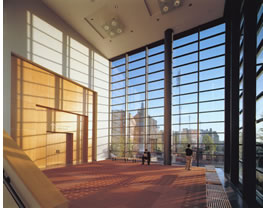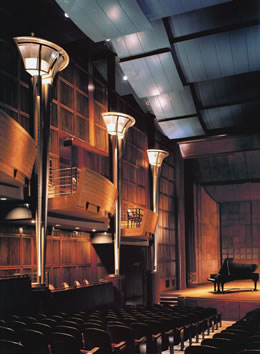
Complex concentrates on blending old and new, creating gathering spaces

Pei Cobb Freed LLP and NBBJ developed a master plan for the College—Conservatory of Music, University of Cincinnati, that is a seven-year, multibuilding study in balance—between renovation and new construction, academic peace and construction schedules, gathering places and study places.
 The
major starting point for the architect, who was charged with doubling
the school's floor area, was: renovate or build anew? The school's existing
precast building, erected in the 1960s, was "crammed like a bone
in the throat of an awkwardly shaped, steeply sloped site between undistinguished
academic and residential buildings," according to the architect.
Additionally, the existing building had been cut off from the rest of
the University of Cincinnati campus by a network of service roads.
The
major starting point for the architect, who was charged with doubling
the school's floor area, was: renovate or build anew? The school's existing
precast building, erected in the 1960s, was "crammed like a bone
in the throat of an awkwardly shaped, steeply sloped site between undistinguished
academic and residential buildings," according to the architect.
Additionally, the existing building had been cut off from the rest of
the University of Cincinnati campus by a network of service roads.
Careful study indicated that while the school's existing performance space and its ancillary service areas could be renovated in a cost-effective manner, the existing academic wing needed to be replaced. By pressing an adjacent abandoned gymnasium and obsolete dormitory into service, the architects renovated 137,000 square feet of space, to which they married 146,370 square feet of new construction.
 In
relation to the existing buildings, it was possible to site the new academic
wing to define one side of a new courtyard that has become the school's
focal point for the music school complex, which now comprises a renovated
proscenium theater; existing 400-seat thrust-stage theater; new recital
hall and studio theater; and numerous renovated and new rehearsal spaces.
To make a complex project even more interesting, the work was conducted
in six discrete construction phases over a period of seven years to avoid
disruption of the school's academic programs.
In
relation to the existing buildings, it was possible to site the new academic
wing to define one side of a new courtyard that has become the school's
focal point for the music school complex, which now comprises a renovated
proscenium theater; existing 400-seat thrust-stage theater; new recital
hall and studio theater; and numerous renovated and new rehearsal spaces.
To make a complex project even more interesting, the work was conducted
in six discrete construction phases over a period of seven years to avoid
disruption of the school's academic programs.
Pei Cobb Freed reports that the project had two
governing ideas:
• The environmental quality of a campus could be enhanced by the
"conservation and imaginative reuse of existing buildings in conjunction
with new constructions"
• The first obligation on any campus building project—beyond
providing required facilities—is to "shape attractive gathering
places, both interior and exterior, that will engender a strong sense
of community."
The architects will receive an AIA Honor Award for Architecture for the conservatory of music at the AIA national convention in Denver, May 17–19.
Copyright 2001 The American Institute of Architects. All rights reserved.
![]()
|
Photos ©Eric Schiller To learn more about the College—Conservatory of Music, click here. To learn about the project from the architect's Web site, click here: |
|